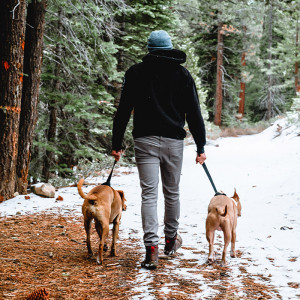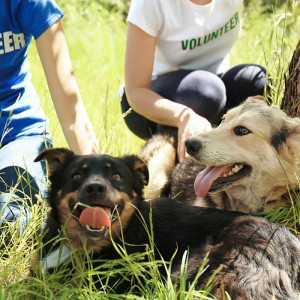Usefull Advice
Christmas advice for dog keepers
What NOT to add to your pet from the Christmas menu? Even if they look at us irresistibly...
- Chocolate – Cocoa contains a substance (theobromine) that dogs cannot digest. It can cause diarrhea, vomiting, abnormal heart rhythms, seizures or even death in large quantities! Especially with chocolate with a high cocoa content.
- Alcohol – Even a small amount can cause vomiting, diarrhea, coordination and breathing problems, breathing difficulties, coma or even death! Let's be very careful. Be careful that your pet does not even accidentally have access to alcohol or alcohol-containing foods!
- Onions – Onions and garlic are harmful to dogs, whether they eat them raw, cooked or dried! Even when consumed in small quantities, it damages red blood cells without causing symptoms.
- Grapes, raisins – Seeds can damage the kidneys. It is not known exactly in what quantities they are dangerous, but it is better to be careful with these delicacies as well.
- Spicy, salty foods – As with humans, overly spicy, salty foods can irritate the stomach, cause vomiting, diarrhea and cramps.
- Xylitol (birch sugar) - Many candies, chewing gum, some toothpaste, some slimming products are sweetened with xylitol, that is, birch sugar. Be careful that your dog never eats any of these. Extremely harmful to the liver! The amount of chewing gum in an eye can be deadly!
Ask our guests not to feed our dog at the table!
New Year's Eve good advice
PREVENTION
0. NOTIFICATION OF PROHIBITED "NOISE-GENERATING PRODUCTS"
We guarantee that those using illegal pyrotechnics (firecrackers, etc.) should be reported to the police!
1. SAFE PLACEMENT OF COMPANION ANIMALS
On the day of the holiday, it is preferable to keep your pets in a safe place, locked up (in an apartment, in a garage). If you can, stay with them.
2. USE OF SEDATIVES
A veterinary medicinal product recommended by your veterinarian should be used to soothe animals sensitive to noise from the morning of 31 December. (Caution: Do not experiment with sedatives registered for humans!) More recently, so-called pheromone evaporators and sprays have been successfully used, which can help animals kept in the apartment get through the excitement of noisy days.
3. UNIQUE IDENTITY
In order to make it easy to identify your pet, we recommend that dogs also have a mandatory microchip inserted into kittens. The advantage of the microchip is that the data of our animal can be read at any time in veterinary clinics, animal shelters and lawn master farms with the help of the national computer system, so that in case of wandering the farmer's data can be retrieved and the stray cattle can be easily returned to its owner. In addition, it is worth placing a tag on the dog's collar with the owner's phone number on it. After all, the finder can easily and quickly notify the dog's owner!
IF THE TROUBLE HAPPENED
If they find an animal thought to be lost:
1. CAPTURE AND RECEPTION
Animals that are the victims of the holiday usually differ from stray animals by appearance (good condition, groomed fur, etc.) and behavior (usually friendly, less shy behavior). If the animal thought to be lost is tame, it is recommended that it be captured as soon as possible and temporarily placed in a calm, safe place.
2. VERIFICATION OF UNIQUE IDENTITY
When the animal found is well handled and easy to transport, it is advisable to take it to a veterinarian, where it is advisable to check if there is a microchip in it, which will help to find out the identity of the owner extremely quickly.
3. NOTIFICATION OF THE FOUND ANIMAL
It is very important to report the data of the found animal (and of course the finder) as soon as possible to the authorities and civil society organizations and forums where the animal can be searched by its owner, and it is also advisable to find out if it is not being searched. At our foundation, you can report to the rexiroda@rex.hu e-mail address for both lost and found animals. To do this, please describe the following information and, if possible, attach a photo of the animal. Data requested: for lost dogs: loss/finding place, time, Dog breed/nature, color, (presumed) age, gender, unique marks (e.g. tattoo), description mark/equipment (e.g. collar, flea circle), known illness or veterinary intervention, name of notifier, telephone number, e-mail address.)
4. Advertising of the FOUND ANIMAL
Can be solved as much as possible, we strongly recommend that the found animal be photographed, data, contact details of the finder, posters and displayed in the area where the animal was found. Or advertising the same data on social media! In many cases, farmers who lose an animal hope that their pet will go home on their own, so they do not always report the animal missing to animal protection organizations. It is useful to put up as many posters as possible in the catchment area of the find.
IF YOU HAVE LOST YOUR ANIMAL
1. NOTIFICATION OF A LOST ANIMAL
It is very important to report the lost animal (and of course the loss) data as soon as possible to the authorities and civil society organizations and forums where the animal can be advertised by its finder, and it is also advisable to find out if a similar animal has been found. At our foundation, you can report to the rexiroda@rex.hu e-mail address for both lost and found animals. It is recommended that you make an announcement in the area of Budapest at the Veterinary Centre of the Metropolitan Public Lands Authority (Address: 1097 Budapest, Fragrant Road 23/A. - phone: 06-1-347-08-30, illatosut@fori.hu),and in the countryside, inquire at the landlords/lawn masters contracted with the municipality.
2. ADVERTISING THE LOST ANIMAL
As much as possible, we strongly recommend that you take a photo of the lost animal, its data, the contact details of the owner, make posters and place them in the area where the animal was lost. It is useful to put up as many posters as possible in the area of the loss. Or advertising the same data on social media! In the case of lost and found animals, it is also very important to indicate the loss or finding of the animal in as many forums as possible.
IS DOG CLOTHES JUST A FASHION BUBBLE?
WINTER DOG FACTS AND MISCONCEPTIONS
The increasingly erratic winter weather in recent years has affected not only us, but also our pets. We try to adapt to the circumstances, but sometimes we make the wrong decision, which can even lead to the disease of the animal. Therefore, the staff of the Rex Foundation have now collected the most common facts and misconceptions about winter dog ownership, in order to help responsible owners, get through the coldest season.
It is not necessarily lazy not to walk
The laziness may not be the reason why our pet has been less enthusiastic about walking in recent times. Sudden temperature changes and fronts can ignite the symptoms of our pets with joint problems. This is what we can suspect if the animal gets up more difficult in the morning, moves carefully, does not like to walk. "The most common cause of symptoms is pains due to chronic inflammation of aging joints," says Dr. Péter Király, founder of the Rex Foundation. – "In severe cases, the pain is permanent as a result of joint degeneration. It tries to relieve the aching joints of the animal, and this can lead to persistent limanship. If such symptoms are observed, consult a veterinarian who will give the dog a medicine that will give the dog the pleasure of movement and can be safely taken in the long term."
A wet nose is not always a good sign
The most common cause of respiratory diseases in dogs and cats is a viral infection, which is often followed by a secondary bacterial infection. Its symptoms may at first be only runny nose, which can later be supplemented with sneezing, cratering, coughing and even loss of appetite. In severe cases, fever, difficulty breathing, and lethargy may also develop. If these symptoms are detected, contact your veterinarian as soon as possible so that targeted treatment can begin before complications develop.
Dog clothes are not fashion bubbles!
On cold winter days, more and more of the room dogs are walking in dog clothes. All this may seem like a fashion bubble for unimpeded eyes, but the reality is that clothing that protects the trunk plays an important role in the prevention of cold diseases. "The layer of sebum impregnating the fur of dogs kept in the apartment is usually thinner as a result of more frequent bathing, thus less protective from the harsh weather conditions. In the rain and snow, the lined and waterproof dog clothes are good for your pet, which protects your pet from both cold and moisture," said Dr King.
Are dog shoes really an exaggeration?
One of the biggest enemies of animals walking on an icy, snowy street is salt, which can bite out their feet. In order to protect our four-legged family members, it is recommended to avoid places sprinkled with salt, as well as to regularly clean the paws of our pet after walks, and then apply it with paddle cream. If a dangerous street is inevitable, we can use a shoe to protect the dogs' feet. The rugged, waterproof dog shoes available today is handy to wear, which protects your dog's paws from both salt milling and ice shards during winter. In addition to the above, the most important thing is that as a responsible keeper, if the problem has happened, do not try to treat your pet based on your own ideas or advice found on the Internet! It is very important that whether it is a cold or a wounded paddle, we should consult a specialist in the early stages of the onset of symptoms, as this is the key to a correct diagnosis and successful treatment.



